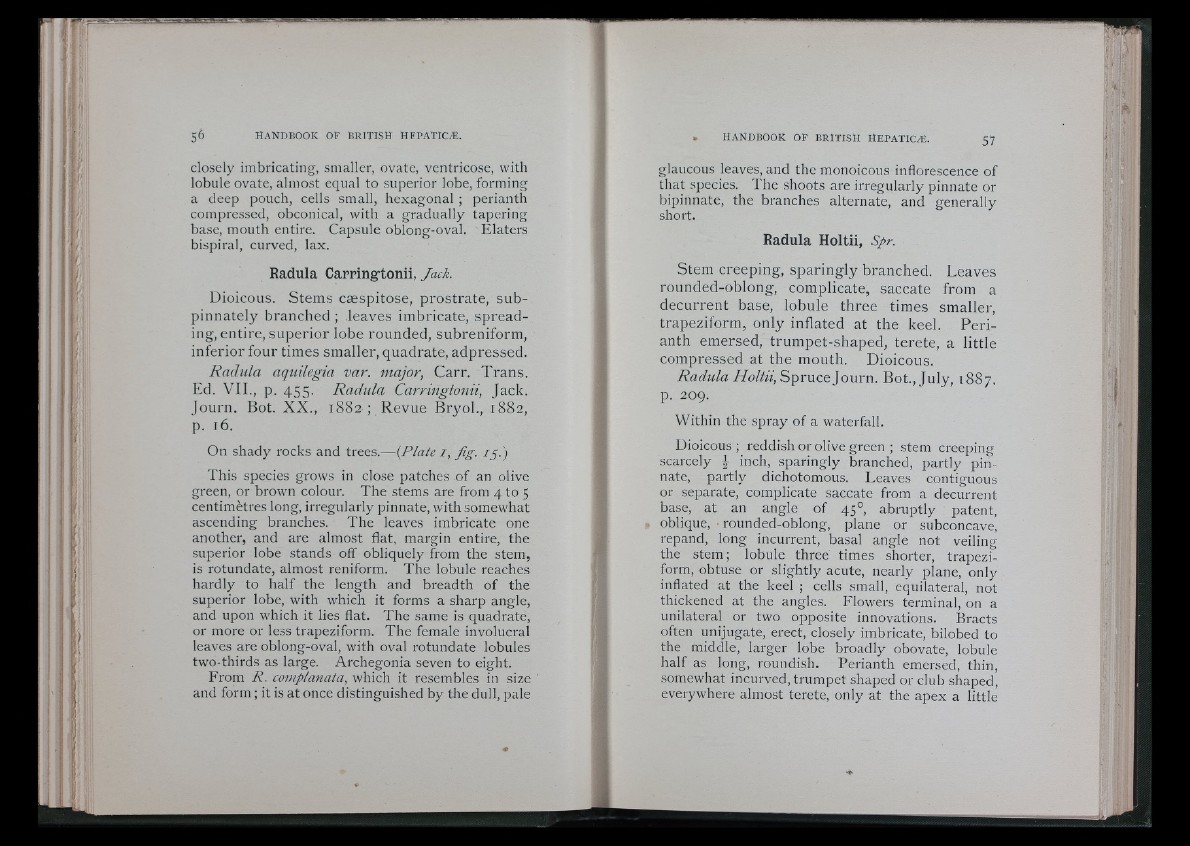
closely imbricating, smaller, ovate, ventricose, with
lobule ovate, almost equal to superior lobe, forming
a deep pouch, cells small, hexagonal ; perianth
compressed, obconical, with a gradually tapering
base, mouth entire. Capsule oblong-oval. Elaters
bispiral, curved, lax.
Radula Carring-tonii, Jack.
Dioicous. Stems cæspitose, prostrate, su b pinnately
branched ; leaves imbricate, spreading,
entire, super ior lobe rounded, subreniform,
inferior four times smaller, quadrate, adpressed.
Radula aquilegia var. major, Carr. Trans .
Ed. VI I . , p. 455. Radula Carringtonii, Jack.
Journ. Bot. X X . , 1882 ; Re vu e BryoL, 1882,
p. 16.
On shady rocks and trees.— {Plate /, jig. ig.)
This species grows in close patches of an olive
green, or brown colour. The stems are from 4 to 5
centimètres long, irregularly pinnate, with somewhat
ascending branches. The leaves imbricate one
another, and are almost flat, margin entire, the
superior lobe stands off obliquely from the stem,
is rotundate, almost reniform. The lobule reaches
hardly to half the length and breadth of the
superior lobe, with which it forms a sharp angle,
and upon which it lies flat. The same is quadrate,
or more or less trapeziform. The female involucral
leaves are oblong-oval, with oval rotundate lobules
two-thirds as large. Archegonia seven to eight.
From R. eomplanata, which it resembles in size
and form ; it is at once distinguished by the dull, pale
glaucous leaves, and the monoicous inflorescence of
that species. The shoots are irregularly pinnate or
bipinnate, the branches alternate, and generally
short.
Radula Holtii, Spr.
Stem creeping, sp a r ing ly branched. Lea v e s
rounded-oblong, complicate, saccate from a
decurrent base, lobule three times smaller,
trapeziform, only inflated at the keel. P e r i anth
emersed, trumpet-shaped, terete, a little
compressed at the mouth. Dioicous.
Radula iVo//«, Spruce Journ. Bot., July, 1887.
p. 209.
Within the spray of a waterfall.
Dioicous ; reddish or olive green ; stem creeping
scarcely inch, sparingly branched, partly pinnate,
partly dichotomous. Leaves contiguous
or separate, complicate saccate from a decurrent
base, at an angle of 45°, abruptly patent,
oblique, rounded-oblong, plane or subconcave,
repand, long incurrent, basal angle not veiling
the stem; lobule three times shorter, trapeziform,
obtuse or slightly acute, nearly plane, only
inflated at the keel ; cells small, equilateral, not
thickened at the angles. Flowers terminal, on a
unilateral or two opposite innovations. Bracts
often unijugate, erect, closely imbricate, bilobed to
the middle, larger lobe broadly obovate, lobule
half as long, roundish. Perianth emersed, thin,
somewhat incurved, trumpet shaped or club shaped,
everywhere almost terete, only at the apex a little